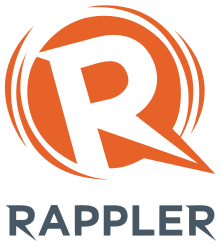Rappler
 | |
| Founded | January 3, 2012 |
|---|---|
| Founder |
Maria Ressa Glenda Gloria Chay Hofilena Beth Frondoso |
| Headquarters | Philippines |
Key people |
Manuel I. Ayala (Chairman) Maria Ressa (President) |
| Revenue | PHP139.46 million (FY 2015)[1] |
| PHP-46.14 million (FY 2015)[1] | |
| Website | www.rappler.com |
Rappler is a citizen journalism website based in the Philippines with a franchise based in Indonesia. It commenced first as a Facebook page called MovePH in August 2011[2] and later evolved into Rappler.com on January 1, 2012.[3] along with web based text news content, it was also among the first news websites in the Philippines to use more video news shot for purpose. It also actively uses social media sites for news distribution.[4]
Its name is a combination of the words rap and ripple.[3]
History
With the idea of professional journalists using social media and crowd sourcing for news distribution,[5] Rappler was started in 2011 by Maria Ressa, a Filipina journalist with her friends.[6] Brainstorming for the company began some time in 2010 when CEO & Executive Editor Maria Ressa was writing her second book “From Bin Laden to Facebook” in Singapore.
Other key people involved in its conceptualization and creation were former Newsbreak Head and ABS-CBN News Channel Managing Editor Glenda Gloria, Journalist and Ateneo De Manila University Professor Chay Hofileña, former TV Patrol Executive Producer Lilibeth Frondoso, Philippine Internet pioneer Nix Nolledo, Internet entrepreneur Manny Ayala and former Nation Broadcasting Corporation executive Raymund Miranda.[7]
It first started a Facebook page called MovePH created in August 2011.[8]
Rappler first went public as a beta version website on January 1, 2012, the same day that the Philippine Daily Inquirer published a Rappler piece that broke out the story of (then) Philippine Chief Justice Renato Corona being awarded a University of Santo Tomas doctoral degree without a required dissertation.[9][10] The site officially launched at its #MoveManila event at the Far Eastern University in Manila on January 12, 2012.[11]
It released its iOS app on February 15, 2013[12] and its Android app on May 20, 2013[13] and went fully functional in August 2013 [14][15]
Mood Meter
One of the distinguishing features of Rappler is its "Mood Meter" consisting of bubbles showing the way people react to certain news.[4] The Mood Meter is embedded on each story. Users are asked “how does this story make you feel?” and are given 8 different emotions to choose from – happy, sad, angry, afraid, annoyed, inspired, amused and don’t care. The top ten stories with the most votes over a 48-hour period appear on the Mood Navigator.[16]
The Rappler Mood Meter won the Bronze Medal for Brand Experience at the 2012 Boomerang Awards sponsored by the Internet Media Marketing Association of the Philippines (IMMAP).[17]
Advocacy
MovePH continues to operate as Rappler’s citizen engagement arm that pushes for real solutions to development issues through the use of media.[8]
Some of MovePH’s advocacies include education, governance, climate change, gender, health, and disaster risk reduction and management.[18]
Rappler organizes the annual Manila Social Good Summit, part of a New York-based initiative organized globally by Plus Social Good, Mashable, the UNDP and the Bill & Melinda Gates Foundation.[19][20]
At the 2013 Manila Social Good Summit, Rappler launched Project Agos, a platform that attempts to increase government and community participation in combatting climate change and disasters.[21][22]
References
- 1 2 "Media Ownership Monitor Philippines - Rappler Holdings Corporation". VERA Files. Retrieved November 24, 2016.
- ↑ "MovePH". MovePH on Facebook. Retrieved May 12, 2014.
- 1 2 Ressa, Maria. "About Rappler". Rappler. Retrieved 20 August 2013.
- 1 2 "First Metro Philippines Investment Summit Partners". Financial Times. Retrieved May 12, 2014.
- ↑ Terence Lee (May 21, 2013). "Philippines' Rappler fuses online journalism with counter-terrorism tactics, social network theory". Tech In Asia. Retrieved May 12, 2014.
- ↑ Colin Chan (April 2, 2012). "Interview with Maria Ressa, CEO of Rappler.com". TheNewMedia.com. Retrieved May 12, 2014.
- ↑ "The People Behind Rappler". Rappler. June 17, 2012. Retrieved May 12, 2014.
- 1 2 "Rappler: MovePH". Rappler. Retrieved May 12, 2014.
- ↑ Marites Dañguilan Vitug (January 2, 2012). "UST breaks rules to favor Corona". Rappler. Retrieved May 12, 2014.
- ↑ "UST breaks rules to favor Corona". Philippine Daily Inquirer. January 1, 2012. Retrieved May 12, 2014.
- ↑ Natashya Gutierrez (January 12, 2012). "Rappler introduced at #MoveManila Chat Series". Rappler. Retrieved May 12, 2014.
- ↑ "Rappler releases iOS app". Rappler. February 15, 2013. Retrieved May 12, 2014.
- ↑ "Rappler launches Android app". Rappler. May 20, 2013. Retrieved May 12, 2014.
- ↑ "Rappler drops beta, officially launches". Rappler. August 23, 2012. Retrieved May 12, 2014.
- ↑ "The new and improved Rappler". Rappler. April 2, 2014. Retrieved May 12, 2014.
- ↑ Adrienne LaFrance (August 13, 2012). "In the Philippines, Rappler is trying to figure out the role of emotion in the news". Nieman Journalism Lab. Retrieved May 12, 2014.
- ↑ Carlo Ople (September 14, 2012). "2012 Boomerang Awards Winners". TheNewMedia.com. Retrieved May 12, 2014.
- ↑ "Join the MovePH Community". Rappler. February 6, 2014. Retrieved May 12, 2014.
- ↑ "Social Good Summit 2013 in Manila". Rappler. Retrieved May 12, 2014.
- ↑ "About Plus Social Good". PlusSocialGood. Retrieved May 12, 2014.
- ↑ "Project Agos". Rappler. Retrieved May 12, 2014.
- ↑ "Heeding the Call: Project Agos Maps Disaster in the Philippines". PlusSocialGood. November 12, 2013. Retrieved May 12, 2014.